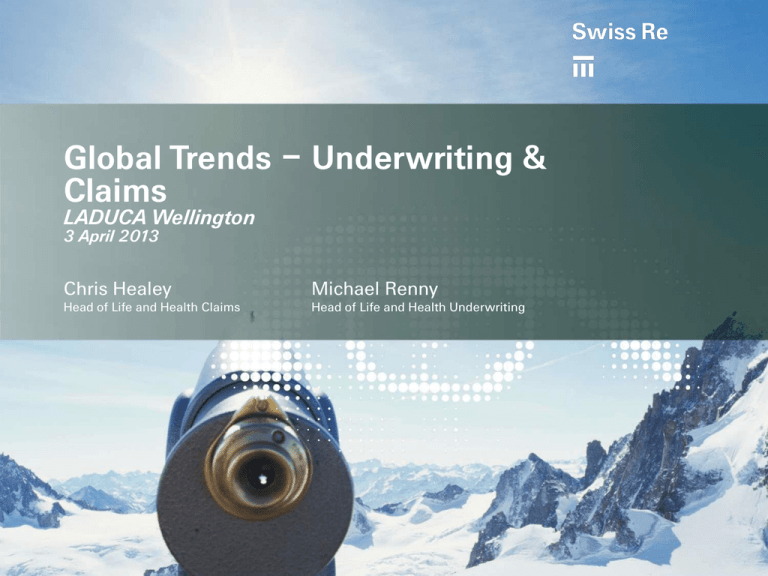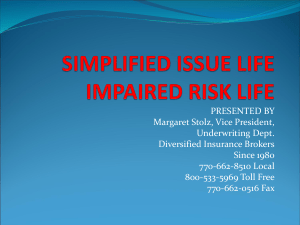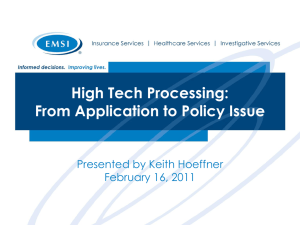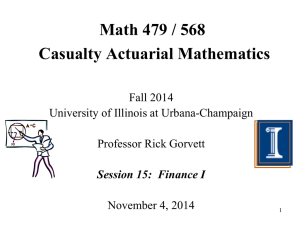
Global Trends – Underwriting &
Claims
LADUCA Wellington
3 April 2013
Chris Healey
Michael Renny
Head of Life and Health Claims
Head of Life and Health Underwriting
Agenda
Then and now
Global Trends
Best Practice
2
The Swiss Re Team
Western Europe: Zurich,
Amsterdam, Milan, Rome,
Paris, Madrid & Tel Aviv
Northern/Eastern Europe:
Munich, Warsaw, Moscow
& Copenhagen
Asia:
Hong Kong,
Beijing, Tokyo,
Seoul,
Singapore,
Sydney, Mumbai
& Bangalore
The Americas:
Armonk, Toronto,
Fort Wayne,
Mexico City &
Bogota
The UK/South Africa:
London, Cape Town
3
Mortality
Critical Illness
Disability
Insurance
Medical
insurance
LTC
Insurance products
4
Then and Now
5
Underwriting and Claims
THEN
NOW
Adviser Relationships
End Customer
SLAs weeks/months
SLAs hours/days
Back Office
Market Differentiation
Back Logs
Segmentation and
Portfolio Management
Medical Approach
Alt Underwriting &
Durations Management
6
Global Trends
7
Cause
Effect
Ageing Population
• Demographics, Mortality & Morbidity
• Product Design
• Underwriting & Claims Approach
Environment and Economy
• Consumer Behaviours & Expectations
• Changing Employment & Personal
Finance Practices
• Age of technology
• Regulatory Challenges
Product Trends
• Critical Illness
8
Cause
Effect
Ageing Population
• Demographics, Mortality & Morbidity
• Product Design
• Underwriting & Claims Approach
Environment and Economy
• Consumer Behaviours & Expectations
• Changing Employment & Personal
Finance Practices
• Age of Technology
• Regulatory Challenges
Product Trends
• Critical Illness
9
Changing Environment:
Elderly Population Growth Globally
# of people
Age 65 or older
Millions
# of people
1200
80
12
%
1000
800
600
400
8
%
10
%
Millions
%
25
20
60
15
10
0
20
0
195
0
197
5
200
0
200
201
5
0
Note : % share over total population
201
5
202
0
202
5
203
0
1950 1975 2000 2005
Source: U.S. Census Bureau
65-74
2010
2015
75-84
Age 65 or older
Millions
40
26%
35
28%
29%
30%
2020
2025
2030
23%
30
25
18%
20
%
2000
2005
20
15
10
5
0
5%
1950
Share of total
population
40
6
%
5
%
200
0
7
%
7
%
8
%
9
%
Age 65 or older
8
%
1975
2010
2015
Note : % share over total population
10
2020
2025
85+
2030
Trends in chronic disease burden
Trends in the prevalence of chronic disease over time
0%
5%
10%
15%
20%
25%
30%
45-64
Cancer
Diabetes
Emphysema
Coronary heart disease
Stroke
1987
1997
2005
Cancer
65-74
Diabetes
Emphysema
Coronary heart disease
Stroke
Cancer
75+
Diabetes
Emphysema
Coronary heart disease
Stroke
National Health Interview Survey
# of
Chronic disease prevalence
by age group
chronic
conditions 65-69 70-74 75-79
0
25.7%
18.9%
15.2%
1
20.4%
18.0%
16.0%
2
22.2%
22.5%
21.6%
3
16.0%
18.7%
19.9%
4+
15.7%
21.9%
27.3%
So What?
This impacts on:
• Demographics, Mortality and Morbidity Experience
• Product Design (Longevity products)
• Underwriting and Claims Approach
12
Cause
Effect
Ageing Population
• Demographics, Mortality & Morbidity
• Product Design
• Underwriting & Claims Approach
Environment and Economy
• Consumer Behaviours & Expectations
• Changing Employment & Personal
Finance Practices
• Age of Technology
• Regulatory Challenges
Product Trends
• Critical Illness
13
Consumer Behaviours & Expectations
• Service expectations
• Focus on personal information and privacy
• Access to insurance
14
Employment Practices
• Unemployment rates
• Self-employment and contracting
• Increasing global wealth
Suicide D eaths Am ong M en
(Individual Line of Business)
45%
Percent of SR Amount
40%
35%
30%
25%
20%
15%
10%
5%
0%
Ages 1 5 - 1 9
Ages 2 0 - 2 9
Ages 3 0 - 3 9
Ages 4 0 - 4 9
2007
2008
15
Ages 5 0 - 5 9
2009
Ages 6 0 - 6 9
ages 7 0 +
Age of Technology
•
Tele-claims to SMS
•
Rules based engines…the new STP
•
Face to Face with a difference
•
Touching all aspects of claims – treatment options & tele-consult
16
The impact of technology – Speed of
decision
Percentage of cases with final decision offered
Source: Swiss Re
Underwriting Watch 2011
17
Proportion of cases taken up
Source: Swiss Re
Underwriting Watch 2011
18
Straight through system processing
70.00%
60.00%
50.00%
40.00%
30.00%
20.00%
10.00%
0.00%
21-30% 31-40% 41-50% 51-60% 61-70% 71-80% 81-90% 91-100%
-10.00%
Life 2007/2008
CI 2007/2008
Life 2010
CI 2010
19
Changes in STP
20
Age of Technology
•
Internet
•
Mobile Devices & Distribution
•
Social Media
21
Insurance & Internet
Holland's
biggest online
comparison
website
(Independer)
has been
bought by
Holland's
biggest
insurer Eureko
22
Insurance & Internet
New
Australian
online
insurance
platform to
help people
better
understand
risk and
appreciate
insurance in
their lives
23
Insurance & mobile devices
Access anywhere
Protection quote application for mobile devices.
Supports URE's
Alternative distribution
24
Insurance & Social Media
Liberty
Mutual (US)
has launched
a campaign
on its
Facebook
page where it
will donate
$5 to a breast
cancer charity
for every life
insurance
quote.
25
Insurance & Social Media
More and more insurance companies are using Social Media sites to
detect insurance fraud. Consumer organisations and lawyers have
argued that scouring social networking sites to find evidence of
insurance fraud, is an invasion of privacy. But insurance companies
and their attorneys argue that they only use public available
information on social media profiles and do not invade any privacy.
26
Regulatory challenges
Started with HIV and genetics
Spilled over to family history
– tests regarded as having a genetic component
Challenges pre-dominantly from Europe but is spreading:
– EU directives on gender, age and disability
– EU access to electronic health records
– UK: Treating Customers Fairly (TCF)
– Singapore: mental illness
– US: travel ratings
– Globally: push for non-contestability clauses
27
Regulatory challenges:
The three issues
Discrimination
Insurers may be unable to
rate on the basis of
discrimination in the
areas of race, gender,
sexual orientation, age,
health, genetic make-up
and travel, or may be
required to justify any
ratings they apply
The key test may be one
of proportionality
Consumer Needs
Insurers may be unable
to make certain types of
enquiry into confidential
information from
applicants
They may also face rules
around the way such
information is stored or
to whom information
may be passed
Entitlement
There may be the view
that access to insurance
is a basic human right for
all citizens to enjoy
28
Germans ethics council:
The right not to know
“It should not be permissible, for the purposes of an insurer’s risk assessment, to
require medical examinations and tests directed towards the identification of risks
unknown to the proposer himself. These constitute a disproportionate encroachment
on the proposer’s personal rights; in particular, they call into question his right to
ignorance”
“Forcing such knowledge on a proposer is distressing, particularly if disorders that are
neither avoidable nor treatable are diagnosed or predicted. Such knowledge may
adversely affect the self-conception of the individual concerned, his future behaviour
and possibly the planning of the entire course of his life”
German National Ethics Council, 2008
29
The ECJ ruling on gender:
A sexless future?
Can we still ask gender questions in underwriting?
Can we differentiate medical tests by gender?
Can we rate based on different lab reference ranges?
How do we approach
– gender specific diseases
– family history
– diseases with greater prevalence in one gender
30
Underwriting:
Born 18th century; died 2011
Cause of Death: Fatal blow from a Gender Directive
Identification of the assailant: Believed to be unisex
31
Cause
Effect
Ageing Population
• Demographics, Mortality & Morbidity
• Product Design
• Underwriting & Claims Approach
Environment and Economy
• Consumer Behaviours & Expectations
• Changing Employment & Personal
Finance Practices
• Motivation for Fraud
• Regulatory Challenges
Product Trends
• Critical Illness
32
Critical Illness Cover
Limited to 6 key Illnesses.
Benefits / Cover restricted to actual costs.
Insurance
view
Clients
view
Good Marketing
Good overlap
Focus on Life style changes or financial impact.
Not a sickness or medical benefit.
Key man critical illness cover was launched in the
late 1980s.
33
But…
34
And now…
Changing purpose…
Medical advances
General information
Media
Public perception
Legal framework
Environment
State-provided medical services
Partial payments
Lifestyle cover?
Lottery?
Insurance
view
Swiss Re & China Pacific Life Insurance
Decrease of overlap
Co. Ltd – Partnership
Client
view
Increased risk of litigation
Diagnosis VS. the required medical
treatment. Protection according to
treatment needs.
35
Definitions
Melanoma
Past definition – "We will pay for a Malignant melanoma which is Clark
Level 3 or 1.5 mm Breslow thickness".
Present definition – "We will pay for a Malignant melanoma which is
ulcerated, or at least a Clark Level 3 or 1.5 mm in depth invasion". Partial
payment for less than this criteria.
Heart attack
Past definition – "or a rise of Troponin I above 2.0ng/ml or Troponin T
above 0.6 ng/ml".
Present definition – "or typical rise and/or fall of cardiac biomarkers". No
reference to Troponin levels.
36
Best Practice
37
What are the best companies doing?
Thought
leadership and
strategic
decision
makers
People
capability,
recruitment
and retention
focus
Overcoming (or
don’t have)
legacy issues
Building a culture of
continuous
improvement
Balancing
customer
service
delivery with
risk
management
Application of
technology
38
Thank you
Legal notice
©2013 Swiss Re. All rights reserved. You are not permitted to create any
modifications or derivatives of this presentation or to use it for commercial
or other public purposes without the prior written permission of Swiss Re.
Although all the information used was taken from reliable sources, Swiss Re
does not accept any responsibility for the accuracy or comprehensiveness of
the details given. All liability for the accuracy and completeness thereof or
for any damage resulting from the use of the information contained in this
presentation is expressly excluded. Under no circumstances shall Swiss Re
or its Group companies be liable for any financial and/or consequential loss
relating to this presentation.
40












